Apple iPhone 4S: Thoroughly Reviewed
by Anand Lal Shimpi & Brian Klug on October 31, 2011 7:45 PM EST- Posted in
- Smartphones
- Apple
- Mobile
- iPhone
- iPhone 4S
The A5 Architecture & CPU Performance
The original iPhone debuted with a single 412MHz ARM11 core built on a 90nm process. The 3G improved network performance in 2008 but left the SoC untouched. It wasn't until the iPhone 3GS in 2009 that the SoC got a major performance and power update. Apple moved to a 65nm process node, a brand new ARM Cortex A8 based SoC and an upgraded GPU. The A4 released in 2010 once again gave us a process shrink but kept the architecture unchanged.
Apple's A5, first introduced with the iPad 2, keeps process technology the same while introducing a brand new CPU and GPU. The A5 integrates two ARM Cortex A9 cores onto a single die. The improvement over the A4 is tremendous. At the single core level, Apple shortened the integer pipeline without reducing clock speed. With a shorter pipeline the A5 gets more done per clock, and without decreasing clock speed the A5 inherently achieves better performance at the same clock. The move to the Cortex A9 also enables out-of-order instruction execution, further improving architectural efficiency. I've heard there's a 20% increase in performance per clock vs. the Cortex A8, but combine that with the fact that you get two A9s vs a single A8 in last year's design and you get a pretty big performance increase.
There are several situations where the A5's two cores deliver a tangible performance benefit over the A4's single core. Like Android, iOS appears to be pretty well threaded. Individual apps and tasks can take advantage of the second core without a recompile or version update. The most obvious example is web browsing.
Mobile Safari is well threaded. Javascript rendering can be parallelized as well as parts of the HTML parsing/rendering process. All of the major Javascript performance benchmarks show a 60 - 70% increase in performance over the A4, which is partially due to the availability of the second core:
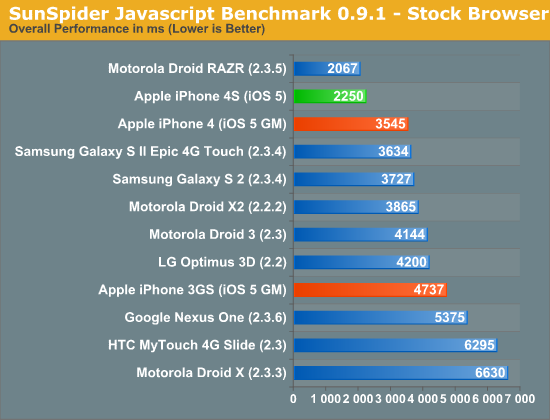
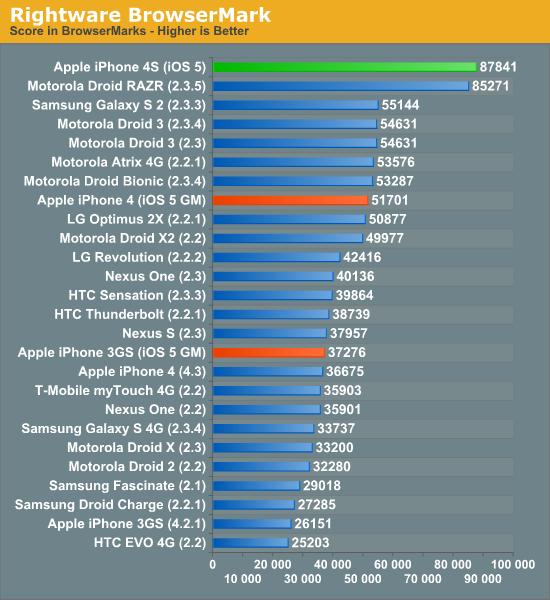
This translates directly into faster page load times. As you can see in the video below, the iPhone 4S (left) loads the AnandTech front page over WiFi in about 5 seconds compared to 9 seconds on the iPhone 4 (right). That's really the best case scenario, the improvement in the next page load time was only about a second (7s vs 8s).
Typical improvements in load time fall in the 10 - 70% range, contributing significantly to the phone feeling snappier than its predecessor. To quantify the improvement I ran through our standard web page loading suite, a test that hits AnandTech, CNN, NYTimes, Engadget, Amazon, Digg and Reddit hosted locally on our lab's network. The average page load time over WiFi for all of the pages is below:
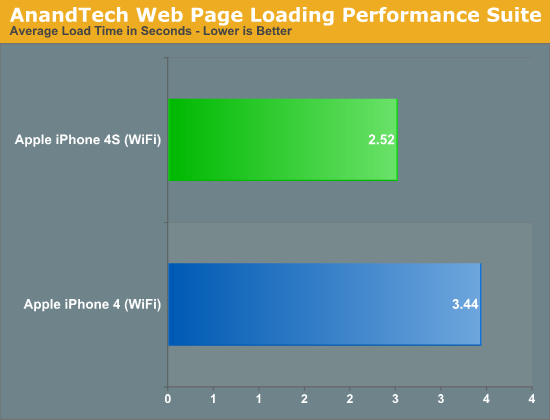
While web page rendering is a natural fit for multiple cores, I was surprised by how poorly threaded some apps ended up being. For example, although I did see performance improvements in exporting edited videos from the iOS version of iMovie, the gains weren't always evident. A quick profile of the app revealed that much of the export process is still single threaded. Just as we've seen on the desktop, there will be some added work necessary to get all apps to utilize multiple cores on iOS.
It's not always performance within an app that saw improvement with the A5: application install and launch times are also much quicker on the 4S. The time to launch Epic's iOS Citadel demo went from 32 seconds on the iPhone 4 to 22 seconds on the 4S. While the iPhone 4 may feel fast enough for many users, the 4S is noticeably faster.
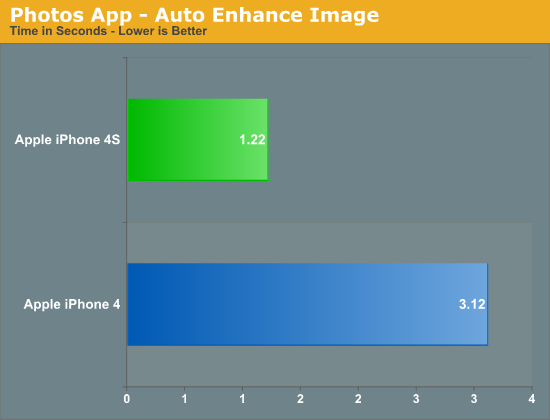
Much of the faster feel comes from by shaving off of seconds here or there. For example, I noticed apps like Messages pop up just slightly quicker on the 4S and you'll see your listing of messages a hair faster than you would on the 4. In the video above you get a brief idea of the sort of subtle improvements I'm talking about. YouTube launches a fraction of a second quicker on the 4S vs the 4.
These subtle decreases in response time are simply icing on the cake. The move from a 4 to a 4S is one of those upgrades that you'll notice right off the bat but will really appreciate if you go back to an iPhone 4 and try to use it. If you do a lot of web browsing on your phone, you'll appreciate the 4S.
I wasn't entirely sure whether or not I could attribute all of these performance improvements to the faster CPU. It's possible that some of the tests I mentioned are IO bound and Apple could have used faster NAND in the 4S. To find out I rounded up a bunch of iPhone 4Ses at all available capacities and measured sequential write speed:
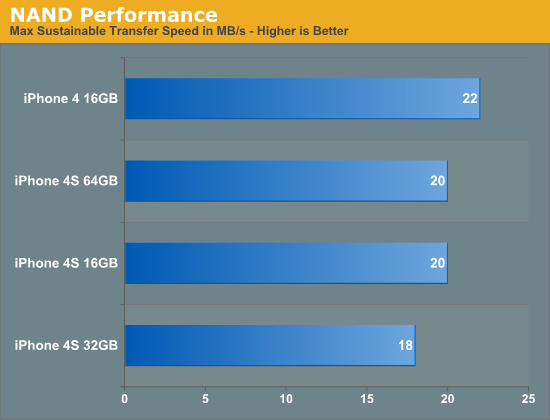
Apple uses multiple sources for NAND so it's possible that you'll see these numbers move around a bit depending on your particular phone. It looks like the iPhone 4S' NAND is no faster than what Apple shipped last year - at least in sequential write speed. The target appears to be 20MB/s and Apple does its best to stay around there. My iPhone 4 is actually pretty quick at 22MB/s but the advantage isn't significant enough to make a huge deal about. I don't have a good way of measuring random IO performance yet but application launch time is largely governed by sequential IO so I don't expect we're seeing gains from anything outside of the CPU and memory bandwidth in the earlier tests.


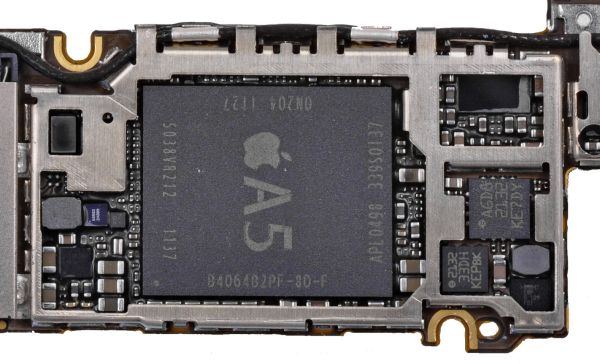








199 Comments
View All Comments
bak0n - Monday, October 31, 2011 - link
It gives my Android something to look up with the Iphone locks up for no apparent reason.cokain - Monday, October 31, 2011 - link
...can you find objective reviews. Quality > quantity.Guspaz - Tuesday, November 1, 2011 - link
I've actually found Siri to be a time saver for sending text messages too. I've not used it much in crowded environments, but when I'm alone or in a car, it's must faster to say "Tell Andrew I've just left and should be there in about half an hour" than it is to unlock the phone, scroll to the messages app, launch the app, find the right contact, and then type the message. Siri lets me skip a lot of the setup there, activating while locked and using "Tell Andrew" to skip a bunch of the steps.deeselcyde - Tuesday, November 1, 2011 - link
Our company just upgraded our 3gs' to the 4s this past week and my phone (through Verizon) rarely gets a 3g signal while everyone else does, heats up to an ungodly temperature, and the battery lasts about 4 hours. Took it in to a "genius" and they said the antenna was screwed up. My replacement should be here tomorrow. I'm hoping it's all good. I'm sure it will be.solipsism - Tuesday, November 1, 2011 - link
Any local voice control or all sent server-side for processing?In other words, when wanted to call a contact or play an artists on the iPhone 4 Voice Control figured it out on the device. Does Siri determine what needs to be to sent to Apple?
solipsism - Tuesday, November 1, 2011 - link
ArsTechnica analyses the data sizes used for Siri. Bottom line: It shouldn't affect most users limited data plans.» http://arstechnica.com/apple/news/2011/11/how-data...
indianidle - Tuesday, November 1, 2011 - link
As a Computer Science grad student, I love the way you guys methodically analyze all the tiny bits that make up a smartphone. As a new iPhone 4S user (just got it last week), I can see why it's so great! Thanks for the review again!Cheers!
shashank7040 - Tuesday, November 1, 2011 - link
and very nice info.shashank7040 - Tuesday, November 1, 2011 - link
Nokia Bendable Phones...........http://goo.gl/NhHKXSunLord - Tuesday, November 1, 2011 - link
Does anyone know if the 4s supports EVDO rev b? Since sprint will be rolling it out next year as part of it's network upgrade?